Melissa Mouchemore‘s latest ferry crossing takes her to the Inner Hebrides.
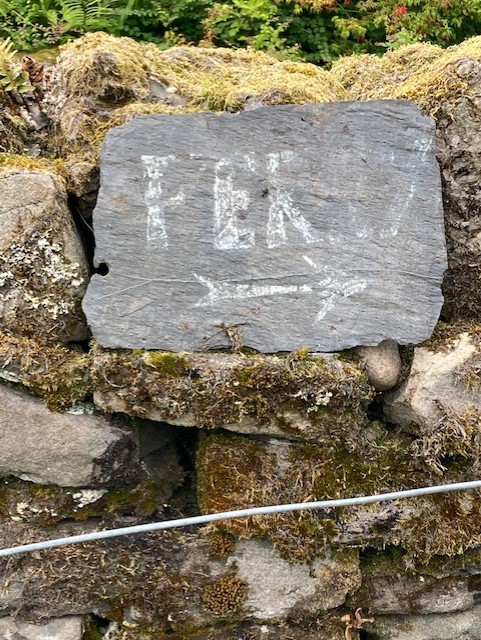
Don’t expect to find the Kerrera ferry mustering with all the others at Oban ferry terminal. The slipway is further on, a couple of miles south-west out of town on the narrow Gallanach road where the houses dwindle and the steep hills reach down to the water. Kerrera is so near the mainland it is easy to make out a quay dotted with sheds, kayaks and streetlights, a dwelling or two further on. And here comes the ferry from that quay, mowing a path across the Sound. The orange lifebuoys along the rail announcing the ferry’s name; Carvoria, rather grand for a little working boat but meaningful to islanders as it comes from the Old Norse for Kerrera. Once long ago I would have been preparing to cross the border from Scotland to Norway. I look across to the curve of Horseshoe Bay where yachts now sail and try to picture it full of Norse longships ready for a skirmish. It is the last ferry before lunchbreak, the assistant announces. The ferryman spins Carvoria round at a clip, perhaps keen to get back to Norway and his sandwiches.
Carvoria is the smallest of the mighty Caledonian-McBrayne ferry fleet serving all the Western Isles. It has room for one car but only the 70 or so islanders can bring vehicles. I will be walking on a near car-free island following a centuries old route described by Hope MacDougall, sister of the first female MacDougall Clan Chief. Over forty years from the 1960s she amassed an extraordinary archive documenting the social history of the Highlands, Islands and in particular Kerrera. She had the perfect vantage point from Dunollie, the MacDougall Clan seat looking down on the island at the northern tip of Oban Bay. And happily, despite her lofty heritage, what fascinated her most was the day-to-day life of the islanders — crofters, weavers, millers, brewers, schoolteachers, postmistresses and, of course, the ferry people. Her 1979 book Kerrera: Mirror of History is gleefully bursting with shopping lists, letters, contracts, bills, rent books, inventories, parish records and stories. So many stories. All the things she was renowned for collecting.
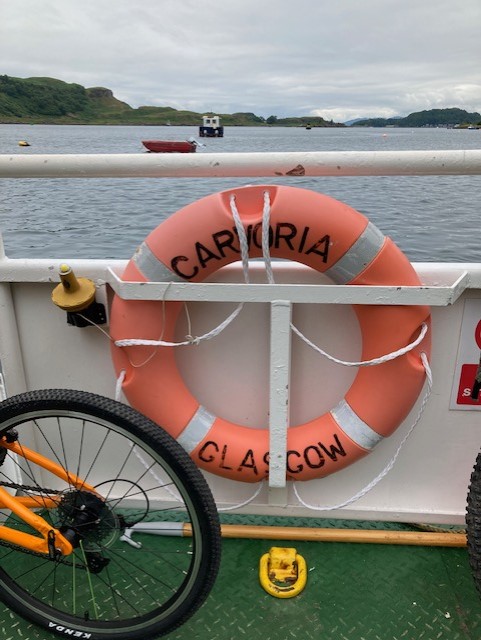
On a map, Kerrera looks like a stepping stone on a giant’s striding route to Mull and beyond. But in front of me now, it is clearly no flat stone, rising proudly out of the green water, layered with all the highland rocks — slate, granite, sandstone, limestone, basalt. A geologist’s field day. No doubt barren and stark in winter but now in July fronded in sage and chive green. Everything is soft — the grey felted sky, the silk water, bladderwrack brocading its surface.
On board a woman is juggling two small boys, their bikes and an armful of John Lewis on-line parcels. The boys interrupt their mum in English accents. That’s a journey back into Oban if something doesn’t fit.
This crossing has always ferried cargoes of post and parcels and long before Click and Collect — before even John Lewis — it was the post-runners who delivered. Their route took them round the island ‘sunwise’, Hope MacDougall’s term, from the quay at Port Kerrera. The mum looks like she could do with a post-runner as she marches down the ramp but at least she has a quad bike waiting to pile in the parcels, bikes and boys.
Once Carvoria has moored, it is as though a door onto a noisy street has shut — the island has the tranquility of a Moroccan riad, only here soothing water burbles from streams not a courtyard fountain. They rush and tumble from the island’s centre crossing under the track, heading for the Sound.
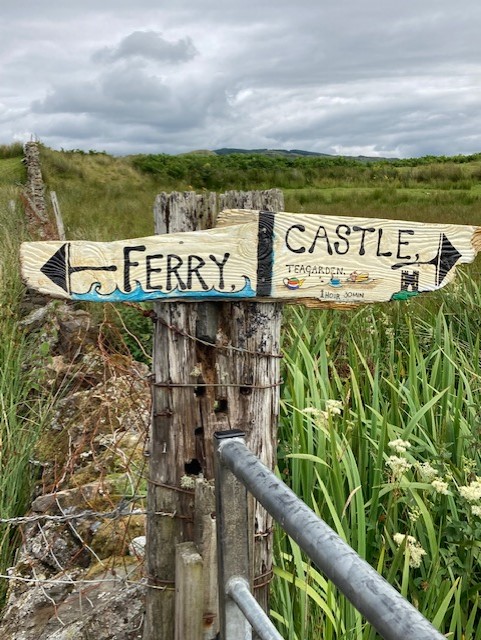
The post-runners must have had summer’s days like this — I wonder if they ever meandered as I am now, if their round ever allowed them time to run their hands through the hedgerows fluffed with long grasses, meadowsweet and knapweed, the warm air alive with bees.
But more often it must have been bog-heath-stream-mud-rock in wind and rain. Drenchings and freezings standard issue, in midwinter in the dark depending when the ferry arrived, with one feeble Post Office lamp to light the way. And wet, heavy mailbags over their shoulders. Gathering up news and passing it on when they stopped for a cup of tea or something stronger.
I am also thinking about tea. Chirpy teapot signs reassure me I am going in the right direction for the bothy as the track steepens through head-high bracken, up past a farmyard, a byre, pastures with sheep and cattle, a yellow digger. And then with relief the teapots tip downhill towards the sweep of Ardmore Bay and the dramatic ruin of Gylen Castle, schools of further isles floating in the Firth of Lorn beyond.
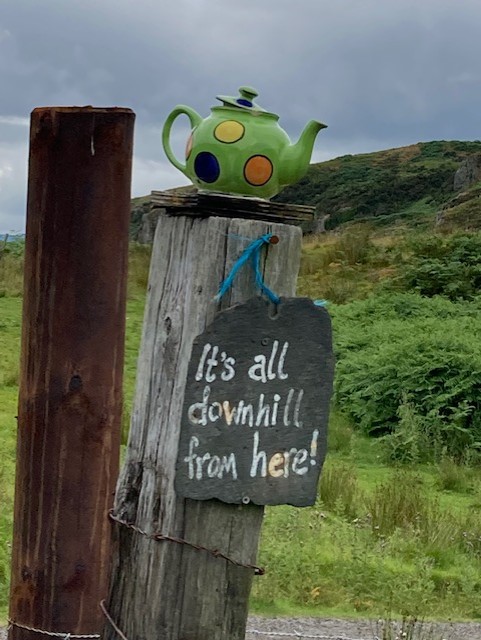
On from tea I keep the Firth to my left. A child’s plastic fire engine awaits instructions by a gate. All the human stuff — the quadbike, the kayaks, the teapots, the digger, the plastic fire engine — has been ferried over. Just as the items in Hope’s inventories were, all with their own stories — a piano for the schoolhouse, the annual Christmas tree brought over by the Dunollie head gardener, a motorbike parceled up in many parts ready to be built. An inventory from 1837 of farming tools and paraphernalia tells of a thriving farming community;
Oak barking irons
Plough chains
Dung wheelbarrows
Harp shovels
Clutch hoes
Mole traps
Beehives
Wire riddles
Peck measures
And if it could be carried by person or pony, the post-runners delivered it.
As I turn away from the south heading north-west the island’s character turns too. No cosy teapots here, no meadowsweet: the rocks reveal themselves, horned sheep bleat plaintively from high ledges. Even on this most balmy of July days the loneliness and toughness of the island is present as I sit on an outcrop of springy heather. The ‘continent’ of Scotland is just a myth here, the islands are all that matter. Mull looms across the Firth. Somewhere over there is Auchnacraig from where one of the most famous of all post-runners, Calum Posta or Malcolm the Post, regularly crossed on the ‘great’ ferry, according to Hope MacDougall ‘one of the wildest and most dangerous ferries in the Western Isles’. Not so great in a storm when up to 4 ferrymen were needed to sail it. But considered so much more reliable than the newfangled steamers that the GPO were prepared to keep funding it.
Down below me on the shore is Barr Nam Boc where Calum Posta landed 3 times a fortnight for nearly half a century before finally retiring in the 1860s. The first 25 years on foot before he was issued with a pony. He would already have travelled from Tobermory around Mull, filling his mail bags. His destination was Oban, his round trip taking in two islands and two ferries. It was said that his lifetime mileage would have taken him 5 and a half times round the world. A true giant on the stepping stone of Kerrera.
The remains of the ferry pier are still there among the greenery for those who have the time and legs to venture off the main path. But I still have to traverse the high centre to return to Port Kerrera in time for Carvoria’s last crossing. I pound up the stony track, then trudge shedding another layer, wishing I had less in my daypack. I wouldn’t be much good as a post-runner. White-washed Barnabuck House where Calum Posta might have stopped for refreshment is soon a white dot below. Although the island is less than 2 miles wide surely the surface area of this up and down inner Hebride is much greater, folding in on itself, bending distance and time. The sheep jeer as I plod on.
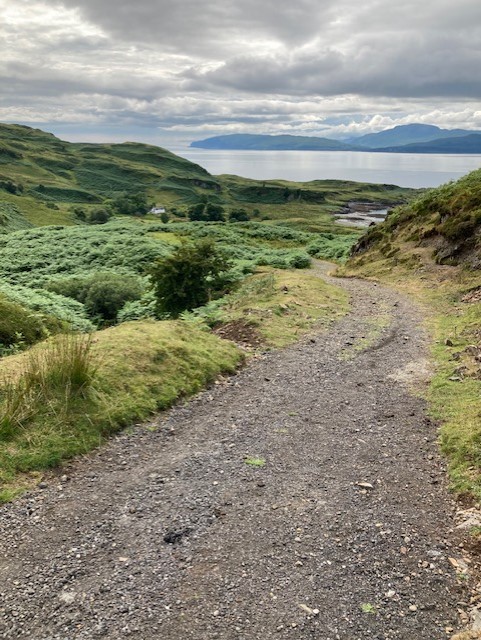
Even before this was Calum Posta’s stepping stone, it was one for the drovers and their cattle from Mull, Tiree and Coll. They also had to brave the ‘great’ crossing in large, broad boats, thick coverings of brushwood inside to protect the hold from hooves. They were on their way to the markets or ‘trysts’ on the mainland and before that they had one more stressful crossing. At the highest point on the path I can see over to the northern tip of Kerrera where a monument stands to Hutcheson the founder of the steamers. Only the slimmest finger of sea divides the island from the mainland here where the CalMac ferries slide in and out of Oban Bay. But the sort of old map that Hope had access to marked this point just below Dunollie as Cow Point. The inter-island cattle were expected to swim over, herded by the drovers in boats. Just as Calum was starting out as a post-runner the cattle swim or ‘floating the cattle’ was finally coming to an end. The Clan Chief, fed up with marauding post-swim, wild-eyed cattle on his land, paid for an upgraded Port Kerrera ferry built with elm from his woods.
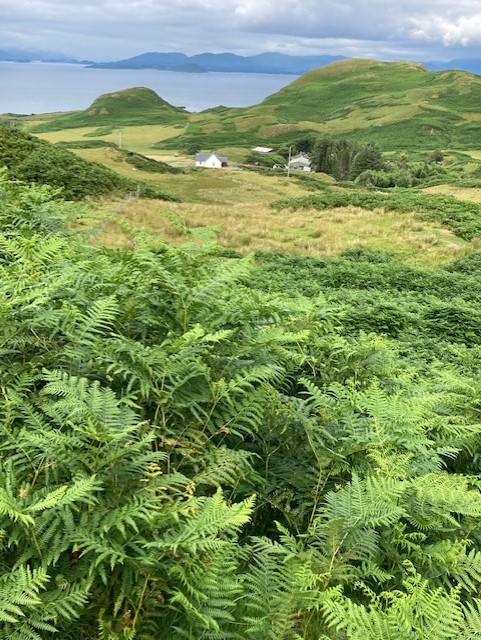
The path smooths, thankfully drops down now to a huddle of buildings, the Sound a gentle sight. I see the old schoolhouse, now planned as a community centre. Calum Posta was a welcome distraction for the ‘scholars’. They would watch out for him striding past the window. He might be carrying something interesting — perhaps a horse saddle or a scythe. What they might not have known was the large sums of money he had with him; he was so trusted that he was often asked to deliver these in addition to his post office duties.
As I arrive with relief for the final ferry, other walkers I last saw at the tea bothy are congregating on the quay. Like us, Calum had this last crossing before he made it to Oban. Here the postmistresses would lay out all the mail against the window panes, address outwards, ready to be picked up when word went round. And then, hopefully after some sort of rest and sustenance, Calum would set off on the return journey. Unlike us, who will be getting into our cars as soon as we land on the other side – the latest in a long line of cargoes and crossings, layered through time like the strata of the highland rocks.